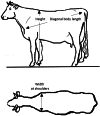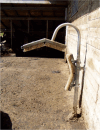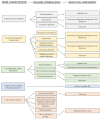Welfare of dairy cows
- PMID: 37200854
- PMCID: PMC10186071
- DOI: 10.2903/j.efsa.2023.7993
Welfare of dairy cows
Abstract
This Scientific Opinion addresses a European Commission's mandate on the welfare of dairy cows as part of the Farm to Fork strategy. It includes three assessments carried out based on literature reviews and complemented by expert opinion. Assessment 1 describes the most prevalent housing systems for dairy cows in Europe: tie-stalls, cubicle housing, open-bedded systems and systems with access to an outdoor area. Per each system, the scientific opinion describes the distribution in the EU and assesses the main strengths, weaknesses and hazards potentially reducing the welfare of dairy cows. Assessment 2 addresses five welfare consequences as requested in the mandate: locomotory disorders (including lameness), mastitis, restriction of movement and resting problems, inability to perform comfort behaviour and metabolic disorders. Per each welfare consequence, a set of animal-based measures is suggested, a detailed analysis of the prevalence in different housing systems is provided, and subsequently, a comparison of the housing systems is given. Common and specific system-related hazards as well as management-related hazards and respective preventive measures are investigated. Assessment 3 includes an analysis of farm characteristics (e.g. milk yield, herd size) that could be used to classify the level of on-farm welfare. From the available scientific literature, it was not possible to derive relevant associations between available farm data and cow welfare. Therefore, an approach based on expert knowledge elicitation (EKE) was developed. The EKE resulted in the identification of five farm characteristics (more than one cow per cubicle at maximum stocking density, limited space for cows, inappropriate cubicle size, high on-farm mortality and farms with less than 2 months access to pasture). If one or more of these farm characteristics are present, it is recommended to conduct an assessment of cow welfare on the farm in question using animal-based measures for specified welfare consequences.
Keywords: dairy cows; husbandry systems; lameness; mastitis; welfare.
© 2023 European Food Safety Authority. EFSA Journal published by Wiley‐VCH GmbH on behalf of European Food Safety Authority.
Figures










Farm characteristics (left side) are considered to lead to specified welfare consequences (central panel) which would be evaluated at herd level using the assessment criteria (right side). Where no herd‐level assessment is present, it was deemed by the expert group that no suitable animal or herd‐based measures were available/feasible for that specific farm characteristic.

*For this elicitation, Stage 1 (individual idea generation) will be conducted remotely prior to the meeting in Parma.


References
-
- Ahdb , 2021. Mobility score. Available online: https://projectblue.blob.core.windows.net/media/Default/Dairy/Publicatio... [Accessed: 21 December 2022].
-
- Albright JL and Arave CW, 1997. The behaviour of cattle. CAB International, Wallingford, UK.
-
- Al‐Marashdeh O, Cameron KC, Bryant RH, Chen A, McGowan B, Gillé‐Perrier C, Carey P, Chrystal J, Hodge S and Edwards GR, 2019. Effects of surface type in an uncovered stand‐off pad system on comfort and welfare of non‐lactating dairy cows during winter. Applied Animal Behaviour Science, 211, 17–24. 10.1016/j.applanim.2018.11.001 - DOI
-
- Alsaaod M, Römer C, Kleinmanns J, Hendriksen K, Rose‐Meierhöfer S, Plümer L and Büscher W, 2012. Electronic detection of lameness in dairy cows through measuring pedometric activity and lying behavior. Applied Animal Behaviour Science, 142, 134–141. 10.1016/j.applanim.2012.10.001 - DOI
LinkOut - more resources
Full Text Sources
Miscellaneous
